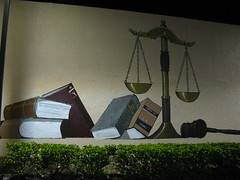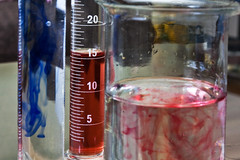On appeal, the appellate court held that the State lacked statutory authority to draw blood as property used as a means to commit misdemeanor DUI. The trial court also found that the blood draw was not authorized by the warrant statute, section 933.02, Florida Statutes, because blood is not “property” used as a “means to commit” a crime:
"In addressing this issue, we should first clarify that although this case was ultimately filed as a felony case based upon Geiss's prior DUI record, the affidavit for the search warrant did not set forth Geiss's complete record, and only averred that Geiss possessed one prior DUI conviction. So, the affidavit alleged probable cause to believe that Geiss had violated the misdemeanor DUI statute. This is significant because section 933.02, Florida Statutes, only allows the state to secure a warrant to seize “property ... used as a means to commit” a misdemeanor. § 933.02(2)(a), Fla. Stat. (2010). By contrast, the statute also authorizes the state to secure a warrant for “property [that] constitutes evidence relevant to proving that a felony has been committed.” § 933.02(3), Fla. Stat. (2010); see also, Bordo, Inc. v. State, 627 So.2d 561, 562–63 (Fla. 4th DCA 1993) (“Thus, property used to commit any crime—whether felony or misdemeanor—may be seized under a warrant; while property merely constituting relevant evidence of a crime may be seized only if the suspected crime is a felony.”). Because the affidavit below only alleged facts supporting probable cause for a misdemeanor DUI, the original issuing magistrate and the trial court reviewing the warrant in the case below properly considered only whether blood constituted “property ... used as a means to commit” the crime of DUI in this case. See, e.g., Martin v. State, 906 So.2d 358 (Fla. 5th DCA 2005) (limiting review to four corners of search warrant to determine whether sufficient probable cause existed). We agree with the trial court that it was not."
Geiss argued that blood is not “property” within the meaning of the statute. The appellate court wrote:
"The statute uses the word “property,” a broad and flexible term that is not defined in the statute. It is a term that should properly be construed in the context of the statute's purpose of identifying items that are the proper subject of a search warrant. In that sense, “property” does not exclude those substances that are naturally produced by the human body. Human blood, whether it is being stored for later transfusion in a hospital refrigerator, being donated to a blood bank or flowing through the veins of an arrestee, is something tangible over which a person or entity may exercise ownership, which has value and which may be sold or transferred for consideration like other material objects. In those important respects, blood is indistinguishable from other fluid materials such as vodka, insulin or gasoline and like each of them may be seized, secured and subjected to chemical and other scientific analysis. The fact that it would require an invasive procedure to extract fluids from the human body does not alter the form or composition of human blood or make it any less suitable a subject for a search warrant.
State v. Isley, 11 Fla. L. Weekly Supp. 1102a (Fla. Brevard County Ct.2004), aff'd, Isley v. State, Case No. 05–2004–AP–59852 (Fla. 18th Cir. Ct. 2005). Other Florida trial courts have reached the same conclusion. See State v. St. George, 16 Fla. L. Weekly Supp. 324a (Fla. Duval County Ct.2009); State v. McKinnon, 16 Fla. L. Weekly Supp. 329a (Fla. Duval County Ct.2009). This reasoning is persuasive. Blood may be extracted from the body and donated and/or sold for further use. And, blood has long been routinely seized for testing as evidence in many types of criminal cases. It only makes sense that the legislature would intend the term “property” to broadly include the types of physical items that would routinely be seized in connection with a criminal investigation."
The appellate court nevertheless found that the search warrant was unauthorized:
"However, we agree that blood is not “used as a means to commit” driving under the influence. Instead, blood is seized for its evidentiary value.FN4 And, no one uses his or her blood “as a means to” do anything, as those words are commonly used or understood. Given that statutes should be construed in accordance with their “plain and ordinary meaning,” Osborne v. Dumoulin, 55 So.3d 577, 581 (Fla.2011) (citations omitted), and that search warrants must strictly conform to the statutes and constitutional provisions which authorize their use, State ex rel. Wilson v. Quigg, 154 Fla. 348, 17 So.2d 697, 701 (1944); Crain v. State, 914 So.2d 1015, 1020 (Fla. 5th DCA 2005) (en banc), we agree with the trial court that blood cannot be drawn based upon probable cause that a suspect has committed misdemeanor DUI in light of the plain language of section 933.02, Florida Statutes.
Unfortunately, applying the good faith exception to warrants as stated in U.S. v. Leon, the appeals court held that the good faith exception to the exclusionary rule applied and reversed the suppression.
Editor's Note: Even though this blood draw squeezed in under the gun due to a 'good faith' exception, such an exception arguably cannot be used again, because the courts have now put the police on notice (through this opinion) that such warrants are legally unauthorized.









![Reblog this post [with Zemanta]](http://img.zemanta.com/reblog_e.png?x-id=f391e3ce-eae5-4e5a-9470-df488ed1e391)

![Reblog this post [with Zemanta]](http://img.zemanta.com/reblog_e.png?x-id=28bc332e-b675-4e8b-9af6-97fdc14da560)